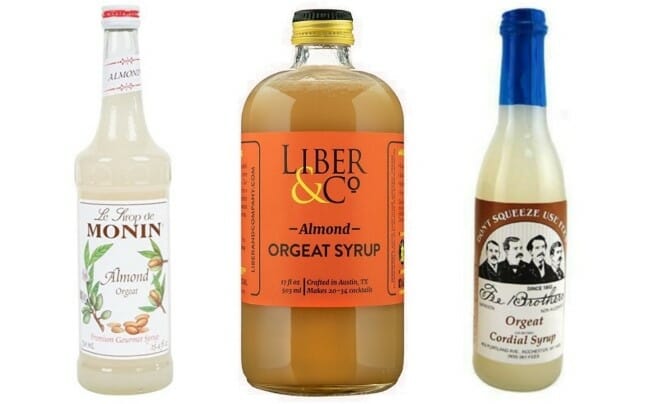Cocktail Queries: What’s the Difference Between Orgeat and Falernum?
Photo via Unsplash, Gianlucca Riccio, Wine Dharma Drink Features rum
Cocktail Queries is a Paste series that examines and answers basic, common questions that drinkers may have about mixed drinks, cocktails and spirits. Check out every entry in the series to date.
Once you’ve ordered your first daiquiri and have begun a head-first dive into the delicious world of classic tiki cocktails, you’ll almost immediately begin noticing the presence of “orgeat” and “falernum” in myriad drink recipes. Together, these two syrups or liqueurs are considered essential to various classic drinks such as the mai tai, the corn ‘n oil, or the zombie. It should be noted, however, that despite sharing some similarities, they are hardly interchangeable. Although often confused for one another, orgeat and falernum are entirely separate ingredients, each with their own unique role to play in the tiki world.
So let’s examine what makes each of them unique, shall we?
Orgeat

Orgeat is a sweet syrup that is primarily known for being flavored with sweet almonds (bitter almonds are not used, as they have high levels of cyanide), giving it a distinctly marzipan-like flavor. If you love almond confections, you’ll probably love orgeat. Modern orgeat is typically made with almonds, sugar and either rose or orange flower water. It is sold as a typically thick, sometimes whitish-colored syrup, and is considered an absolutely essential ingredient in the mai tai, a classic tiki cocktail made with rum, orgeat, curacao, lime juice and simple syrup.
Internationally, though, orgeat is consumed in many avenues outside of tiki cocktails, in nations such as Malta, Suriname, Cyprus and Greece. In Tunisia and Libya, it’s a traditional wedding aperitif, its white color an apparent symbol of purity. It bears mentioning that these variations upon orgeat are all typically being consumed as syrups mixed into non-alcoholic drinks, and orgeat itself is traditionally non-alcoholic.
In the western world, however, orgeat is largely known as an essential tiki ingredient. Its flavor is quite sweet, rich and nutty, which means it works well alongside big, bold rum concoctions, almost always balanced out by the bright acidity of citrus juices. Indeed, it’s the kind of ingredient you need to be careful about using, because its candy-sweet almond flavor can overpower more subtle drinks. You’ll often see orgeat used in cocktails in volumes as small as .5 or .25 fluid oz as a result. It’s meant to be a background note in a complex flavor profile.
Orgeat doesn’t only play with rum, however. There are classic tiki recipes such as the Saturn that combine orgeat with gin, passionfruit and lemon juice, for instance, and the rise of tiki culture has likewise introduced orgeat to a much wider variety of cocktail applications.
So how does it differ from falernum, then, if both are based on the humble almond?
Falernum

Falernum is sometimes referred to as “velvet falernum” for its thick, silky texture as a syrup or liqueur. This has led some drinkers to believe that falernum and “velvet falernum” are in some way distinct concepts, but it’s really just a matter of naming convention—the two terms mean the same thing as far as commercial versions are concerned.
Like orgeat, falernum is a sweet syrup is traditionally made with sweet almonds, but rather than stopping there, falernum takes things several steps farther. It almost always contains flavors of ginger, lime and allspice in addition to the almond infusion, and often has cloves as well. This gives it a much more complex profile than orgeat, with a higher level of acidity and also a spicy punch from the ginger and dry spices. As a result, its almond flavoring is likely to be a bit more subtle, because there’s just more going on. Like orgeat, it’s typically used in small doses to give drinks an extra punch of flavor.
It should be noted that the most widely commercially available, bottled falernums are also alcohol based, which is an important distinction compared with orgeat. The most famous commercial brand, John D. Taylor’s Velvet Falernum from Barbados, runs a mere 11% ABV, but other commercial brands like The Bitter Truth Golden Falernum (18% ABV) and Brovo Spirits Lucky Falernum (35% ABV) can be quite a bit higher. These falernums are primarily used for cocktail purposes, but as liqueurs they are also often consumed on the rocks.
At the same time, however, concoctions labeled as “falernum” are also available as non-alcoholic syrups and mixers, as the defining factor of falernum is more the combination of flavors (almond, ginger, lime, spices) than whether or not alcohol is present. Non-alcoholic versions are available from companies such as Fee Brothers or Tippleman’s.
Falernum is considered a must for myriad classic tiki cocktails, often appearing in ones where maximum complexity is desired, such as the Zombie. At the same time, however, it is also used in very simple cocktails like the Corn ‘n Oil, which is nothing more than blackstrap rum, a little bit of falernum and a lime wedge. You’ll never have to look far in order to find tiki recipes that call for it.
Can You Substitute for Orgeat and Falernum?
Now that you know what makes orgeat and falernum distinct, there’s the obvious question: How big a deal is it to sub one for the other?
When it comes to recipes that call for orgeat, it’s a bit of a stretch to sub in falernum, because it has so many additional flavors involved—the ginger, the lime, the allspice, etc. The resulting drink might still taste great, but it will be pretty far from what is intended if a recipe calls for orgeat. If you’re looking to make a traditional mai tai, there’s really no substitute.
If you have a recipe that calls for falernum, on the other hand, and all you have is orgeat, you can make a closer approximation of the former by adding additional ingredients. That could be as simple as adding some cinnamon or allspice-forward additional bitters to the drink, or some ginger syrup, or you can literally transform a small amount of orgeat into what is more or less like a slightly larger amount of falernum. Invaluable tiki resource The Lost Tiki Lounge cites the following recipe for subbing orgeat in for falernum, involving the addition of overproof rum, lime juice, sugar, ground clove and ground ginger. It’s a little bit of work, and requires eventual straining of the new liqueur you’ve created, but it will get you most of the way there.
Or, you know … you can just buy bottles of both! All roads in tiki lead to orgeat and falernum eventually, after all. Snap up a few bottles and get ready to experiment in this most delicious family of cocktail creations.
Jim Vorel is a Paste staff writer and resident liquor geek. You can follow him on Twitter for more drink writing.